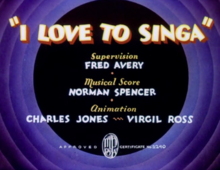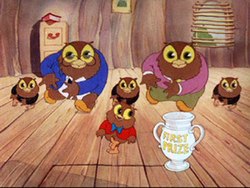
Looney Tunes is an American animated franchise produced and distributed by Warner Bros. It began as a series of short films that originally ran from 1930 to 1969, concurrently with its partner series Merrie Melodies, during the golden age of American animation. Following a revival in the late 1970s, new shorts were released as recently as 2014. The two series introduced a large cast of characters, including Bugs Bunny, Daffy Duck, and Porky Pig. The term Looney Tunes has since been expanded to also refer to the characters themselves.
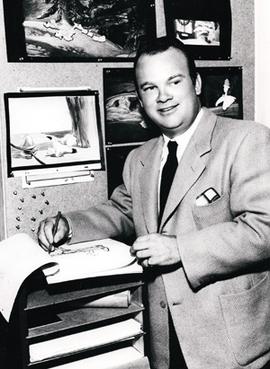
Frederick Bean "Tex" Avery was an American animator, cartoonist, director, and voice actor. He was known for directing and producing animated cartoons during the golden age of American animation. His most significant work was for the Warner Bros. and Metro-Goldwyn-Mayer studios, where he was crucial in the creation and evolution of famous animated characters such as Bugs Bunny, Daffy Duck, Porky Pig, Elmer Fudd, Droopy, Screwy Squirrel, The Wolf, Red Hot Riding Hood, and George and Junior.

Porky in Wackyland is a 1938 Warner Bros. Looney Tunes animated short film, directed by Bob Clampett. The short was released on September 24, 1938, and stars Porky Pig venturing out to find the last do-do bird, which he finds in Wackyland, a land that makes no sense located in Darkest Africa.

Merrie Melodies is an American animated comedy short film series distributed by Warner Bros. Pictures. It is the companion series to Looney Tunes, and featured many of the same characters. It originally ran from August 2, 1931, to September 20, 1969, during the golden age of American animation, though it was revived in 1979, with new shorts sporadically released until June 13, 1997. Originally, Merrie Melodies placed emphasis on one-shot color films in comparison to the black-and-white Looney Tunes films. After Bugs Bunny became the breakout character of Merrie Melodies and Looney Tunes transitioned to color production in the early 1940s, the two series gradually lost their distinctions and shorts were assigned to each series randomly.

Cecil Turtle is a fictional character in the Warner Bros. Looney Tunes and Merrie Melodies series of films. Though he made only three theatrical appearances, Cecil has the unusual distinction in that he is one of the very few characters who were able to outsmart Bugs Bunny, and the only one to do so three times in a row and at the rabbit's own game. Cecil often gives Bugs the taunting nickname of "Speedy" when addressing the rabbit.
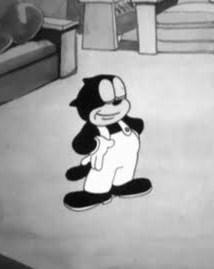
Beans the Cat is an animated cartoon character in the Warner Bros. Cartoons series of cartoons from 1935–1936. Beans was the third Warner Bros cartoon character star after Bosko and Buddy. He was voiced by Billy Bletcher. He was created by director Friz Freleng. The character was featured in nine cartoons made in 1935 and 1936.
Warner Bros. Cartoons, Inc. was an American animation studio, serving as the in-house animation division of Warner Bros. during the Golden Age of American animation. One of the most successful animation studios in American media history, it was primarily responsible for the Looney Tunes and Merrie Melodies series of animated short films. The characters featured in these cartoons, including Bugs Bunny, Daffy Duck, and Porky Pig, are among the most famous and recognizable characters in the world. Many of the creative staff members at the studio, including directors and animators such as Chuck Jones, Friz Freleng, Robert McKimson, Tex Avery, Robert Clampett, Arthur Davis, and Frank Tashlin, are considered major figures in the art and history of traditional animation.

A Wild Hare is a 1940 American animated comedy short film directed by Tex Avery, produced by Leon Schlesinger, and distributed by Warner Bros. as part of the Merrie Melodies series. The film was released on July 27, 1940, and features Elmer Fudd and Bugs Bunny, the latter making what is considered his first official appearance.

The Heckling Hare is a Merrie Melodies cartoon, released on July 5, 1941, and featuring Bugs Bunny and a dopey dog named Willoughby. The cartoon was directed by Tex Avery, written by Michael Maltese, animated by soon-to-be director Robert McKimson, and with musical direction by Carl W. Stalling. In a style that was becoming typical of the Bugs character, he easily outwitted and tormented his antagonist through the short, his only concern being what to do next to the dog.
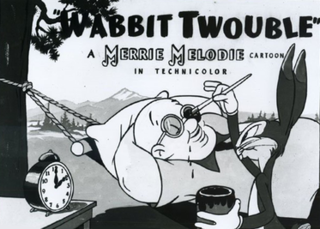
Wabbit Twouble is a Merrie Melodies cartoon starring Bugs Bunny, produced by Leon Schlesinger Productions and released on December 20, 1941, by Warner Bros. Pictures.

Elmer's Candid Camera is a 1940 Warner Bros. Merrie Melodies cartoon short directed by Chuck Jones. The short was released on March 2, 1940, and features Elmer Fudd and an early Bugs Bunny prototype.

Hare-um Scare-um is a 1939 Warner Bros. Merrie Melodies cartoon directed by Ben Hardaway and Cal Dalton. The short was released on August 12, 1939, and is the third short to feature the rabbit that would evolve into Bugs Bunny.

Bugs Bunny and the Three Bears is a 1944 Merrie Melodies cartoon short directed by Chuck Jones and written by Tedd Pierce. The short was released on February 26, 1944, and features Bugs Bunny. This short marks the first appearance of Jones' dysfunctional version of The Three Bears, and is a parody of the old fairy tale, Goldilocks and The Three Bears.
Robert Cameron Bruce Jr. was an American voice actor and the son of Robert Cameron Bruce (1887–1948) who was a cinematographer and documentary producer. He was the narrator for a number of Warner Bros. cartoons in the 1930s and 1940s. The Looney Tunes and Merrie Melodies series' had occasional entries which were driven not by one of their stable of stars such as Bugs Bunny or Daffy Duck, but by individual short sketches, usually filled with sight gags and word-play. Later he was a writer and producer of industrial motion pictures based in Minnesota.
Of Fox and Hounds is a 1940 Warner Bros. Merrie Melodies directed by Tex Avery. The short was released on December 7, 1940, and introduces Willoughby the Dog. Avery performed the voice of Willoughby, and Mel Blanc voiced George the Fox and the bear's yells. The short is an attempt to duplicate the success of the 1940 Bugs Bunny short A Wild Hare by giving another anthropomorphic animal the same unflappable demeanor. The names of Tex Avery, Dave Monohan, Carl W. Stalling, and possibly Charles McKimson intentionally draft numbers in the credits.

Looney Tunes Golden Collection: Volume 5 is a Looney Tunes collection on DVD. Following the pattern of one release each year of the previous volumes, it was released on October 30, 2007.
Dangerous Dan McFoo is a 1939 Warner Bros. Merrie Melodies cartoon directed by Tex Avery. The short was released on July 15, 1939.
The Woods Are Full of Cuckoos is a 1937 Merrie Melodies cartoon directed by Frank Tashlin. The short was released on December 4, 1937.
Goofy Groceries is a 1941 Warner Bros. Merrie Melodies animated short film directed by Bob Clampett. The short was released on March 29, 1941.
Tex Avery Screwball Classics is a series of single-disc Blu-ray and DVD sets by Warner Bros. Home Entertainment's Warner Archive unit collecting various theatrical cartoons from animation director Tex Avery during his tenure at the Metro-Goldwyn-Mayer studio's cartoon division between the years of 1942 and 1955. It is the first comprehensive collection of Avery's MGM shorts to be released on home media in North America since The Compleat Tex Avery series of laserdiscs in the 1990s, with many of the shorts having been previously unreleased on DVD or Blu-ray.
